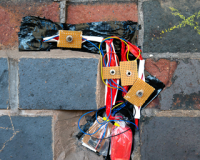Posted on Thu 26 May 2016
Resonating Concrete
So after a little bit of a relay race (Sam in Sweden and at Supersonic fest, Tim in the studio and rehearsing at Bristol Old Vic) we have a decision on what Geiger-Müller Sound System will be pursuing for the rest of our PM Studio residency.

Posted by
Project

Studio Residencies 2012: Geiger-Muller Sound System
Supported by a Studio Residency writer, performer and composer Timothy X Atack and musician, sound artist and instrument designer MrUnderwood developed a finite kinetic choir.
So after a little bit of a relay race (Sam in Sweden and at Supersonic fest, Tim in the studio and rehearsing at Bristol Old Vic) we have a decision on what Geiger-Müller Sound System will be pursuing for the rest of our PM Studio residency.
We've also decided to document it by using these blog posts as a sort of public conversation, chucking ideas around and playing devil's advocate with each other online. Technical ignorance (mine) geeky joy (Sam's) plus mistakes, u-turns, crashed deadlines and broken dreams, yes folks, it's all going to be up here for you to 'delight' in.
So in that spirit, we've decided that I'll summarise the decision we made today, vagaries included, and then Sam will begin to interrogate it below the line. So. *rubs hands*. Let's see what happens.
We're calling our project:
Finite Radioactive Choir
or
Harmonium
or
Tönenteil
or
Half-Life
or something like that, and...
It's a series of standalone sound-producing units made of concrete, containing a loudspeaker and very few additional exterior features – no buttons or switches are visible. They're powered by long life batteries which are re-charged kinetically (eg when the unit is carried around in a bag.) They will eventually lose power completely when the cell deteriorates... so their operation is potentially very lengthy, but finite, and difficult to prolong without going so far as to hack into or crack open the unit.
Within the concrete casing, a mercury tilt switch is used so that the unit can be turned on and off – depending on which side the unit rests on, it emits a different sound. So for instance, one side might play a single note that when united with another unit, forms a chord. Resting it on another side might tell a story or activate an announcement. In addition some units might contain other sensors or receivers -- for short-wave radio or light sensitivity, further modifying the output. So in short, every one of these units has a different 'personality', a different voice and potentially a very different kind of behaviour.
In the first instance we're most likely to build one or two of these units. But ultimately we're imagining up to 100 of them, to be left randomly in different locations around the country, to be found and collected by anyone who might be interested. A date and a URL are engraved on the concrete box. There is then an open-access website that allows people to document their findings, maybe to arrange meetings or 'performances', to chart the progress of each unit. But beyond this initial deployment of the boxes, Geiger-Muller Sound System has no control over what will eventually happen to them. Thanks to the tilt switch operation of power, some will 'die' sooner than others. Some might simply collect dust or get thrown away. But with any luck, a good number will have a documented life, and some might even be operating in 100 years' time.
(Can I also add that if anyone is nerdy enough to recognise the Doctor Who reference in this blog title, well... I probably won't be at all surprised, actually.)
